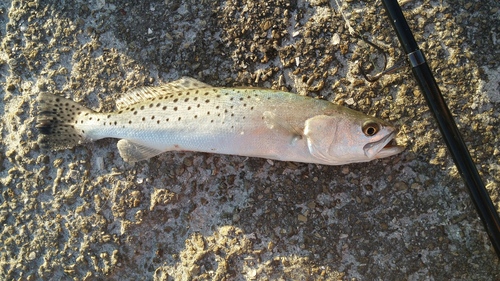
Spotted seatrout
The Atlantic bluefin tuna (Thunnus thynnus) is a magnificent and highly migratory species of tuna. Renowned for its size, speed, and commercial value, this powerful fish plays a vital role in the marine ecosystem. This article will delve into different facets of this fish.
4 10 years
Lifespan
19 - 81 cm
Length
Least Concern
Conservation Status
15 km/h
Swimming speed
Carnivorous
Diet
Local Migration
Migration
Appearance Overview
The Atlantic bluefin tuna is a large, torpedo-shaped fish with a metallic blue-black back and a silver-white belly.
Coloration
Dark metallic blue on top, silvery-white underside
Fins
Two dorsal fins, the first depressible into a groove
Body shape
Torpedo-shaped, built for speed and endurance
Finlets
Small finlets running from the dorsal and anal fins to the tail
Length
Up to 13 feet (4 meters)
Weight
Up to 2,000 lbs (907 kg)
Diet
Carnivorous, feeding on a variety of fish, squid, eels, and crustaceans.
Feeding Behavior
Highly active predator that hunts by sight, often using bursts of speed to capture prey. They may feed cooperatively, herding prey fish into tight balls.
Social Behavior
Forms large schools, especially when young. They are highly migratory, undertaking long trans-Atlantic journeys.
Commercial Relevance
Extremely high value, particularly in the Japanese sushi and sashimi market. A single fish can be worth tens or even hundreds of thousands of dollars.
Conservation measures
Subject to international fishing quotas and management plans through organizations like ICCAT. Marine Protected Areas and seasonal closures are also used.
Status
Endangered (IUCN)
Threats
Overfishing (historically and continuing in some areas), bycatch in fishing gear, climate change affecting prey distribution.
Habitat Distribution
Depth Range
0-1,000 meters (0-3,280 feet), but typically found in the upper layers of the water column.
Geographic Range
North Atlantic Ocean, including the Mediterranean Sea. Western Atlantic population ranges from Newfoundland to the Gulf of Mexico; Eastern Atlantic population ranges from Norway to the Canary Islands.
Preferred Environment
Primarily pelagic, inhabiting temperate and subtropical waters. They prefer open ocean environments but can also be found in coastal areas.
Reproduction and Life Cycle
Breeding Habits
Spawns in warm waters, primarily in the Mediterranean Sea and the Gulf of Mexico. Spawning occurs in large aggregations.
Development Stages
Eggs are pelagic and hatch into larvae. Larvae are planktonic and undergo rapid growth, developing into juveniles and eventually adults.
Fecundity
Highly fecund; a large female can release up to 30 million eggs per spawning season.
Maturity Age
Reaches sexual maturity at around 4-8 years, depending on the population (Eastern Atlantic populations mature earlier than Western Atlantic).
Faqs about Spotted seatrout
Where can I find Atlantic bluefin tuna?
Atlantic bluefin tuna are found throughout the North Atlantic Ocean and the Mediterranean Sea.
How long do bluefin tuna live?
They can live up to 40 years.
Are bluefin tuna still fished?
Yes, but their populations are severely depleted, and strict regulations govern their fishing.
What is the role of bluefin tuna in the ecosystem?
They are apex predators, playing a crucial role in regulating populations of their prey species.
How fast can bluefin tuna swim?
They can reach speeds of up to 43 mph (70 km/h) in short bursts.
Are they warm-blooded?
Bluefin tuna are warm-blooded, unlike most fish, which allows them to maintain a higher body temperature than the surrounding water, aiding in muscle efficiency.
Copyright @ Nature Style Limited. All Rights Reserved.
 English
English